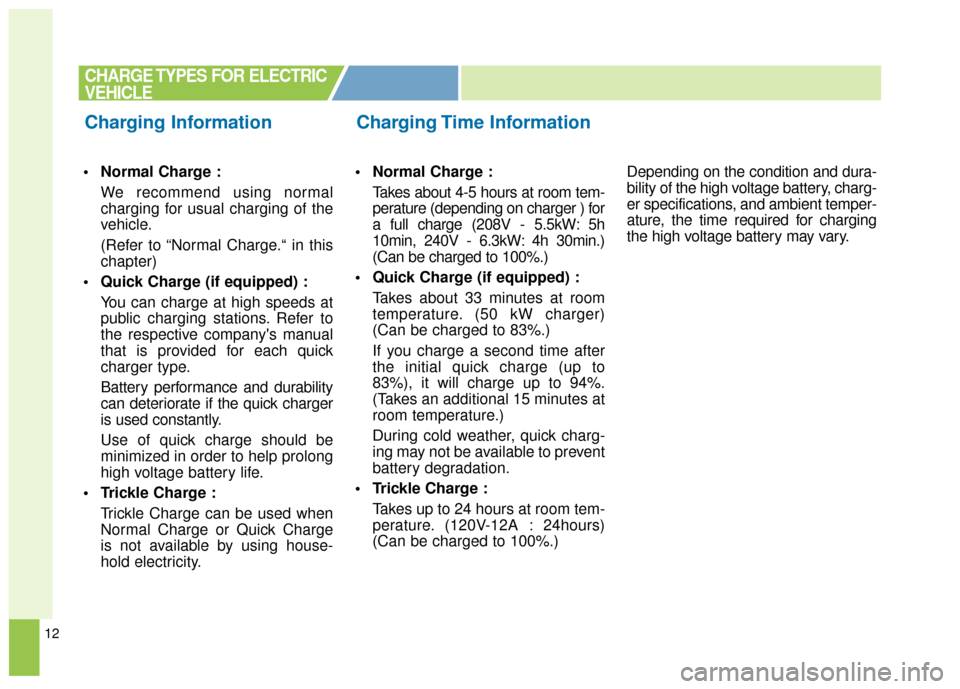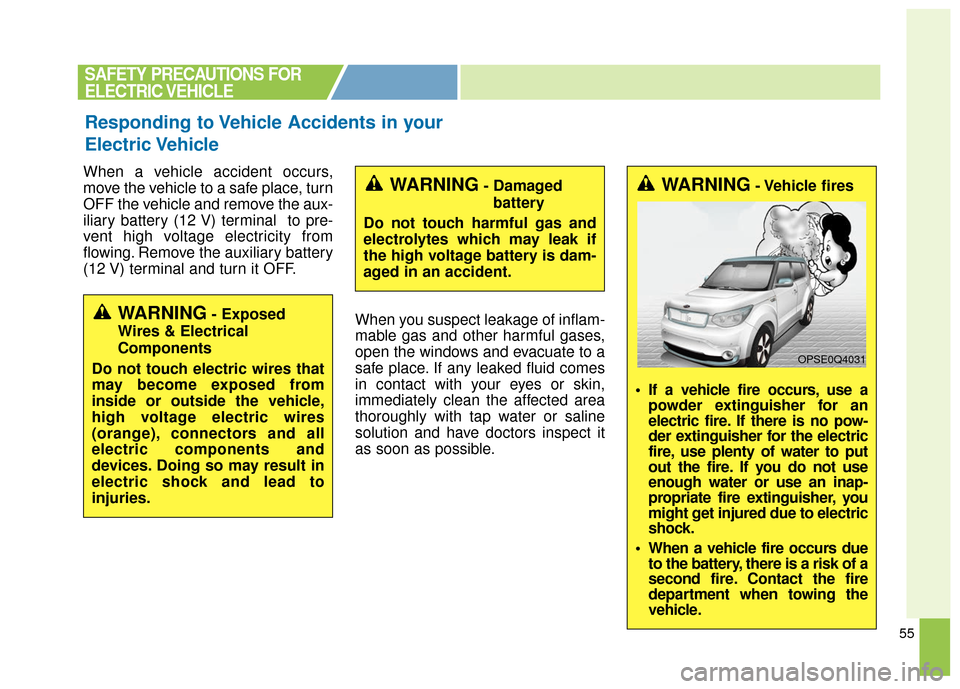Page 473 of 524
8
■ ■Near by stations
Stations around the current location
is searched. Depending on the sym-
bol color of the station, it is catego-
rized as Reachable area, Risky area
and Unreachable area.
■ ■Energy Information
You can check battery information
and power consumption.
� � Battery Information
You can check the available range,
battery charge amount that can be
used, and approximate expected
charging time for each charge type.
More accurate time will be
appeared while charging.
� �Power Consumption
Power that is consumed by the
drive system, climate and electri-
cal components are displayed
respectively.
You can check how far the vehicle
can drive currently, and how much
more the vehicle can drive if the
climate is turned OFF.
EV MODE
Page 477 of 524

12
Normal Charge :We recommend using normal
charging for usual charging of the
vehicle.
(Refer to “Normal Charge.“ in this
chapter)
Quick Charge (if equipped) : You can charge at high speeds at
public charging stations. Refer to
the respective company's manual
that is provided for each quick
charger type.
Battery performance and durability
can deteriorate if the quick charger
is used constantly.
Use of quick charge should be
minimized in order to help prolong
high voltage battery life.
Trickle Charge : Trickle Charge can be used when
Normal Charge or Quick Charge
is not available by using house-
hold electricity. Normal Charge :
Takes about 4-5 hours at room tem-
perature (depending on charger ) for
a full charge (208V - 5.5kW: 5h
10min, 240V - 6.3kW: 4h 30min.)
(Can be charged to 100%.)
Quick Charge (if equipped) : Takes about 33 minutes at room
temperature. (50 kW charger)
(Can be charged to 83%.)
If you charge a second time after
the initial quick charge (up to
83%), it will charge up to 94%.
(Takes an additional 15 minutes at
room temperature.)
During cold weather, quick charg-
ing may not be available to prevent
battery degradation.
Trickle Charge : Takes up to 24 hours at room tem-
perature. (120V-12A : 24hours)
(Can be charged to 100%.) Depending on the condition and dura-
bility of the high voltage battery, charg-
er specifications, and ambient temper-
ature, the time required for charging
the high voltage battery may vary.
CHARGE TYPES FOR ELECTRIC
VEHICLE
Charging Information Charging Time Information
Page 492 of 524
27
You can charge at high speeds at pub-
lic charging stations. Refer to the
respective company's manual that is
provided for each quick charger type.
Battery performance and durability can
deteriorate if the quick charge is used
constantly in hot weather conditions
(heat wave, etc.)
Use of quick charge in hot weather
condition should be minimized in order
to help prolong high voltage battery life.
❈Shape of charger and how to use
the charger may be different for
each manufacturer. ❈
If you use a quick charger when
the vehicle is already fully
charged, some quick chargers will
send out an error message. When
the vehicle is fully charged, do not
charge the vehicle.
■ ■
How to Connect Quick
Charger
1. While the brake pedal is pressed,
engage the parking brake.
2. Turn OFF all switches, place the shift lever in P (Park), and turn
OFF the vehicle.
Quick Charge (if equipped)
CHARGING ELECTRIC VEHICLE
(QUICK CHARGE)
OPSE0Q4004
OPSE0Q4011
■ Quick Charger
Page 496 of 524
31
■ ■How to Disconnect Quick
Charger
1. Remove the charging connector
when quick charging is completed,
or after you stop charging using
the quick charger. Refer to each
respective quick charger manual
for details about how to discon-
nect the charging connector.
CAUTION
Depending on the condition anddurability of the high voltagebattery, charger specifications,and ambient temperature, thetime required for charging thebattery may vary.
Operation of Charging
Indicator Lamp
Details
(1)(2)(3)
�(OFF)�(OFF)�(OFF)Not Charged
Blinking�(OFF)�(OFF)
Charging
0~33%
�(ON)Blinking�(OFF)34~66%
�(ON)�(ON)Blinking67~94%
BlinkingBlinkingBlinking
Error while charging
/If charging cables
are connected when the vehicle is in theready mode or the
POWER button is in the ON position.
OPSE0Q4019
CHARGING ELECTRIC VEHICLE
(QUICK CHARGE)
Page 520 of 524

55
When a vehicle accident occurs,
move the vehicle to a safe place, turn
OFF the vehicle and remove the aux-
iliary battery (12 V) terminal to pre-
vent high voltage electricity from
flowing. Remove the auxiliary battery
(12 V) terminal and turn it OFF.When you suspect leakage of inflam-
mable gas and other harmful gases,
open the windows and evacuate to a
safe place. If any leaked fluid comes
in contact with your eyes or skin,
immediately clean the affected area
thoroughly with tap water or saline
solution and have doctors inspect it
as soon as possible.
SAFETY PRECAUTIONS FOR
ELECTRIC VEHICLE
Responding to Vehicle Accidents in your
Electric Vehicle
WARNING- Exposed
Wires & Electrical
Components
Do not touch electric wires that
may become exposed from
inside or outside the vehicle,
high voltage electric wires
(orange), connectors and all
electric components and
devices. Doing so may result in
electric shock and lead to
injuries.
WARNING- Damaged battery
Do not touch harmful gas and
electrolytes which may leak if
the high voltage battery is dam-
aged in an accident.WARNING- Vehicle fires
If a vehicle fire occurs, use a powder extinguisher for an
electric fire. If there is no pow-
der extinguisher for the electric
fire, use plenty of water to put
out the fire. If you do not use
enough water or use an inap-
propriate fire extinguisher, you
might get injured due to electric
shock.
When a vehicle fire occurs due to the battery, there is a risk of a
second fire. Contact the fire
department when towing the
vehicle.
OPSE0Q4031